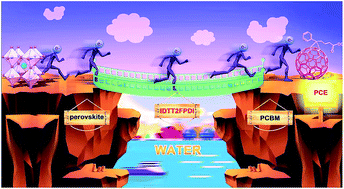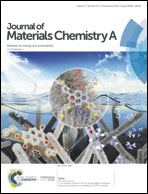Achieving efficient inverted perovskite solar cells with excellent electron transport and stability by employing a ladder-conjugated perylene diimide dimer†
Abstract
The lack of organic electron transport materials (ETM) with excellent electron transport and device stability is an important problem for the development and commercialization of perovskite solar cells (PSCs). Herein, a ladder-conjugated perylene diimide dimer containing an indacenodithiophene unit, namely IDTT2FPDI, was synthesized in two steps with high yields. In addition, IDTT2FPDI exhibits suitable energy levels, high electron mobility, and an excellent hydrophobicity because of its multiple fused thiophene rings and large ladder-conjugated framework. Compared with inverted PSCs which typically use PCBM as a single electron transport layer (ETL), the device utilizing IDTT2FPDI/PCBM as a double ETL showed a better power conversion efficiency (PCE) of 19.4%. Moreover, the double ETL-based devices exhibited superior stability compared with the single ETL-based devices due to the hydrophobicity of the IDTT2FPDI layer. These results highlight the potential of employing ladder-conjugated PDI dimers as ETMs to obtain high-efficiency and stable PSCs, which shows promise for the development of PSCs.



 Please wait while we load your content...
Please wait while we load your content...